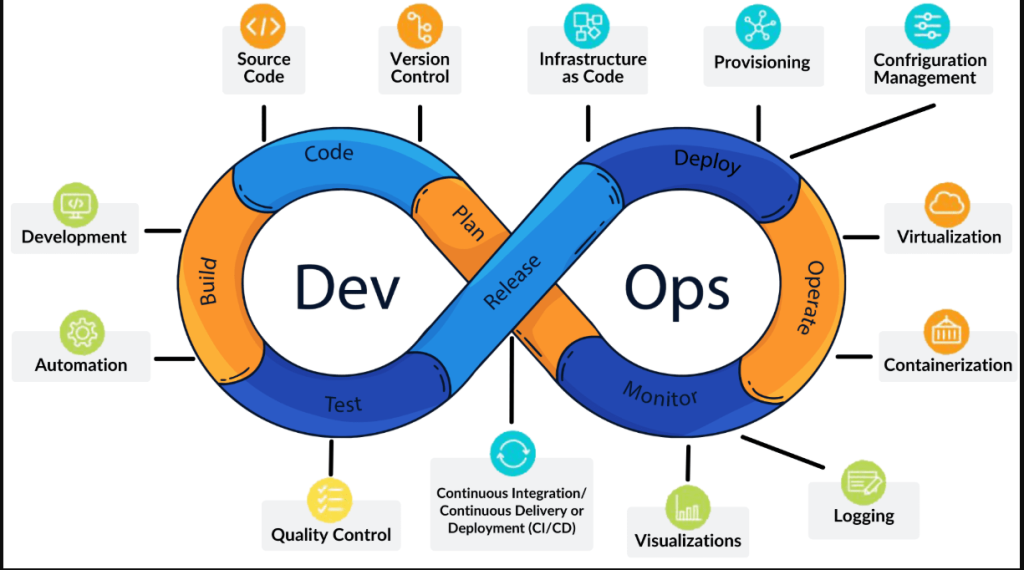
Here’s a comprehensive post titled “Microservices and DevOps: How They Work Together for CI/CD” with expanded content for each section:
The Power of Microservices and DevOps
In the modern software development landscape, Microservices and DevOps are two key practices that work together to create agile, scalable, and efficient systems. Microservices architecture involves breaking down an application into smaller, independent services that can be developed, deployed, and scaled individually. DevOps is a set of practices that aims to improve collaboration between development and operations teams, with an emphasis on automation, continuous integration (CI), and continuous delivery (CD).
When combined, Microservices and DevOps enable teams to achieve faster development cycles, higher deployment frequency, and improved reliability. This combination provides a streamlined approach to CI/CD, ensuring that applications can be built, tested, and released rapidly and efficiently. In this post, we’ll explore how these two practices work together to optimize CI/CD processes in modern software development.
Key Features of Microservices and DevOps in CI/CD
- Microservices: Independent, modular services that enable flexibility, scalability, and faster deployment cycles.
- DevOps: Collaborative culture and practices focusing on automation, testing, and continuous integration for smoother delivery pipelines.
- CI/CD: Automation of build, testing, and deployment processes to enable faster and more reliable software releases.
1. The Role of Microservices in DevOps and CI/CD
Microservices are a natural fit for DevOps and CI/CD due to their independent, modular nature. Instead of dealing with a large, monolithic application, microservices break the system into smaller services, which can be independently deployed, updated, and scaled.
Benefits of Microservices in DevOps for CI/CD
- Independent Service Development and Deployment: With microservices, each service can be developed, built, and deployed independently. This accelerates the development process and reduces the risk of impacting other parts of the system when deploying changes.
- Faster Release Cycles: As each microservice can be updated and deployed separately, development teams can release new features or fixes for individual services faster, without having to wait for changes to other services.
- Easier Rollbacks and Hotfixes: Since microservices are decoupled, a failed update in one service doesn’t affect the entire application. This makes it easier to implement rollbacks and quickly address issues in specific services.
- Automated Testing and Continuous Integration: Microservices lend themselves well to automated unit and integration testing, which is a crucial part of DevOps and CI/CD pipelines. Each microservice can have its own test suite, making it easier to ensure quality across the system.
Microservices enable smaller, manageable pieces of an application to be built and tested independently, speeding up the CI/CD pipeline and allowing more frequent releases.

2. DevOps Practices That Support CI/CD with Microservices
DevOps is all about collaboration, automation, and efficiency. For microservices architectures, DevOps practices help to streamline development processes, promote automation, and enable smooth deployment cycles.
Key DevOps Practices for Microservices and CI/CD
- Continuous Integration (CI): DevOps practices encourage developers to frequently integrate their changes into a shared repository. In microservices, this means each service is continuously integrated with the rest of the system, ensuring compatibility and reducing integration issues.
- Continuous Delivery (CD): Once integration is complete, CD ensures that the updated services are automatically tested and deployed to production environments. Microservices allow for automated, independent deployment of services, which enhances agility and reduces deployment risk.
- Automated Testing: Automated testing is essential to ensure that each service works as expected in isolation and when integrated with other services. CI/CD pipelines automatically trigger testing and validation of services, reducing manual intervention.
- Infrastructure as Code (IaC): IaC practices, such as using Terraform or Ansible, allow teams to automatically provision, manage, and configure infrastructure. This is particularly useful for managing the diverse and dynamic environments that microservices often require.
- Monitoring and Logging: DevOps emphasizes the importance of continuous monitoring and logging of services in production. Microservices benefit from tools like Prometheus, ELK Stack, and Grafana to track performance, availability, and errors in real-time, ensuring better visibility and quicker issue resolution.
These practices align well with the CI/CD model for microservices, automating the workflow, and ensuring smooth transitions from development to production.
3. Continuous Integration and Continuous Delivery in Microservices
CI/CD pipelines are the cornerstone of DevOps and are particularly beneficial when working with microservices. With multiple services being developed and deployed independently, having automated pipelines for each microservice ensures that updates are quickly and safely pushed to production.
Key Benefits of CI/CD in Microservices
- Automated Build and Deployment: Each microservice has its own pipeline, which automatically handles the building, testing, and deployment of services. This reduces human error and ensures that the latest code is deployed to production as quickly as possible.
- Rapid Feedback: Continuous integration allows developers to receive rapid feedback on their code quality, reducing the time it takes to detect and fix bugs or issues within individual services.
- Parallel Development: Different teams can work on different services simultaneously without blocking each other’s progress. This reduces bottlenecks in the development cycle and ensures that the system evolves rapidly.
- Reliable and Safe Deployments: With CD, services are deployed incrementally and independently. This makes the deployment process more predictable and allows for faster recovery in case of failures, minimizing downtime.
- Seamless Rollbacks: If a microservice deployment fails, the system can easily roll back to the previous stable version of that service without affecting the rest of the system. This ensures higher system availability and reduces the risk of large-scale failures.
By leveraging CI/CD pipelines, DevOps practices allow microservices to be rapidly developed, tested, and deployed, ensuring that new features or fixes are delivered to users quickly and reliably.
4. Challenges in Implementing CI/CD for Microservices
While microservices and DevOps practices bring numerous benefits, implementing CI/CD pipelines for microservices can present several challenges. These challenges are often related to the complexity of managing multiple services and ensuring they work together cohesively.
Challenges in CI/CD with Microservices
- Complexity in Managing Multiple Pipelines: Each microservice requires its own CI/CD pipeline, which can quickly become complex to manage. Ensuring that each service is properly integrated and deployed requires careful pipeline configuration.
- Service Dependencies: Microservices often depend on one another, and managing the interdependencies during the CI/CD process can be tricky. Updates to one service might require coordinated updates to others, which can complicate deployment.
- Testing Complexity: Testing microservices requires ensuring that individual services function correctly in isolation and work well together in the integrated system. Automated testing tools must be robust enough to handle this complexity.
- Monitoring and Observability: While monitoring and logging are vital in microservices architectures, collecting and correlating logs and metrics from multiple, independently deployed services can be difficult.
- Infrastructure Management: Microservices typically require different environments for development, testing, staging, and production, which can increase the complexity of infrastructure management and require tools like Kubernetes or Docker for containerization and orchestration.
Despite these challenges, organizations can leverage modern DevOps tools and strategies to address them, ensuring efficient and reliable CI/CD workflows for microservices.
5. Tools and Technologies for Microservices CI/CD
To implement effective CI/CD for microservices, several tools and technologies can help automate processes, improve visibility, and simplify management. These tools integrate with DevOps workflows to facilitate smooth development, testing, and deployment cycles.
Popular Tools for Microservices CI/CD
- Jenkins: A widely used automation server that supports building, testing, and deploying microservices in a CI/CD pipeline.
- Docker: Containerization is essential for microservices, and Docker allows developers to package microservices and their dependencies into containers that can be deployed consistently across environments.
- Kubernetes: A powerful container orchestration tool that manages the deployment, scaling, and operation of microservices in production environments, helping automate container management and load balancing.
- GitLab CI/CD: GitLab’s integrated CI/CD pipelines provide an easy way to implement automated build, test, and deployment processes for microservices.
- Prometheus and Grafana: These monitoring tools help collect metrics, log data, and visualize the performance of microservices, which is essential for maintaining system health and detecting issues early.
- Helm: A package manager for Kubernetes that simplifies the deployment and management of microservices applications.
These tools help ensure that the CI/CD pipeline for microservices remains automated, scalable, and manageable, making it easier to deploy, monitor, and scale the system.
6. The Future of CI/CD and Microservices
As microservices continue to dominate software development, the future of CI/CD will evolve to address emerging needs, such as increased automation, better observability, and improved integration across different services. The integration of AI and machine learning into CI/CD pipelines, the rise of serverless architectures, and the increasing complexity of microservices architectures will drive the next wave of innovation.
Future Trends in Microservices CI/CD
- AI and Machine Learning for Automation: The integration of AI and machine learning in CI/CD pipelines will enhance automation, predictive testing, and intelligent decision-making, further improving deployment efficiency.
- Serverless and Microservices Integration: As serverless computing becomes more popular, expect CI/CD pipelines to support serverless microservices, automating scaling and deployment without the need to manage infrastructure.
- Greater Use of Service Meshes: Service meshes like Istio will provide advanced features for managing microservices communication, security, and monitoring, simplifying CI/CD workflows for complex systems.
- Enhanced Observability: Future CI/CD tools will provide more powerful observability features, allowing for easier tracking of service health, performance, and user behavior across multiple microservices.
Microservices and DevOps: A Perfect Match for CI/CD
Microservices and DevOps are a natural fit for implementing CI/CD in modern software development. Together, they enable teams to build, test, and deploy applications more rapidly, reliably, and with greater flexibility. By leveraging the right tools and practices, organizations can achieve seamless integration and continuous delivery of their microservices applications, ensuring that they meet the demands of today’s fast-paced software development environment.
With microservices, DevOps practices, and robust CI/CD pipelines in place, software teams can stay ahead of the competition, continuously deliver value to customers, and ensure system reliability and performance at scale.
